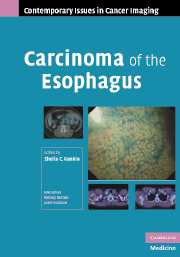Book contents
- Frontmatter
- Contents
- Contributors
- Series foreword
- Preface to Carcinoma of the Esophagus
- 1 Epidemiology and Clinical Presentation in Esophageal Cancer
- 2 Pathology of Esophageal Cancer
- 3 Recent Advances in the Endoscopic Diagnosis of Esophageal Cancer
- 4 Endoscopic Ultrasound in Esophageal Cancer
- 5 CT in Esophageal Cancer
- 6 FDG-PET and PET/CT in Esophageal Cancer
- 7 The Role of Surgery in the Management of Esophageal Cancer and Palliation of Inoperable Disease
- 8 Chemotherapy and Radiotherapy in Esophageal Cancer
- 9 Role of Stents in the Management of Esophageal Cancer
- 10 Lasers in Esophageal Cancer
- Index
- References
6 - FDG-PET and PET/CT in Esophageal Cancer
Published online by Cambridge University Press: 08 August 2009
- Frontmatter
- Contents
- Contributors
- Series foreword
- Preface to Carcinoma of the Esophagus
- 1 Epidemiology and Clinical Presentation in Esophageal Cancer
- 2 Pathology of Esophageal Cancer
- 3 Recent Advances in the Endoscopic Diagnosis of Esophageal Cancer
- 4 Endoscopic Ultrasound in Esophageal Cancer
- 5 CT in Esophageal Cancer
- 6 FDG-PET and PET/CT in Esophageal Cancer
- 7 The Role of Surgery in the Management of Esophageal Cancer and Palliation of Inoperable Disease
- 8 Chemotherapy and Radiotherapy in Esophageal Cancer
- 9 Role of Stents in the Management of Esophageal Cancer
- 10 Lasers in Esophageal Cancer
- Index
- References
Summary
Introduction
The anatomical imaging techniques of computer tomography (CT) and endoscopic ultrasound (EUS) have limitations in the staging of esophageal cancer, in assessing response to therapy, and in predicting survival. Functional imaging using positron emission tomography (PET) has been shown to provide unique information in other tumors and is increasingly being used in oesophageal cancer.
Positron emission tomography
PET is an imaging technique that can map functional activity before structural changes have taken place and has established a recognized place in imaging cancer. The most commonly used isotope at the present time is 18F-fluoro-2-deoxy-d-glucose (FDG), which can differentiate malignant from normal tissue based on the enhanced glucose transport and glycolysis exhibited by many tumor cells. FDG is a glucose analogue, and both FDG and glucose are taken up by cells via the membrane glucose transporter system and are phosphorylated by hexokinase. Unlike glucose, FDG-6-phosphate does not cross the cell membrane and is trapped in cells and is visualized. It can be dephosphorylated, but this is a slow process particularly in cancer cells that lack or have reduced levels of glucose-6-phosphatase. FDG accumulation depends on the rate of transport through the cell membrane that is mediated by glucose transporters (GLUT). Many malignant cells, including gastrointestinal tumors, show increased expression of GLUT-1, contributing to increased FDG accumulation, and this correlates with tumor invasiveness and poor survival in some cancers.
- Type
- Chapter
- Information
- Carcinoma of the Esophagus , pp. 85 - 106Publisher: Cambridge University PressPrint publication year: 2007



